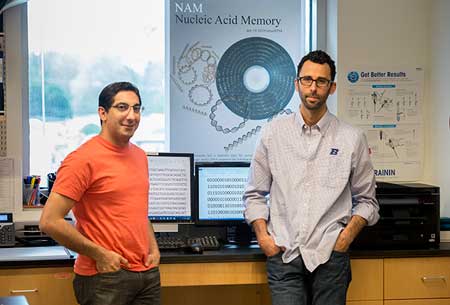| Posted: Apr 27, 2016 |
Biology may hold key to better computer memory
(Nanowerk News) A group of Boise State researchers, led by associate professor of materials science and engineering and associate dean of the College of Innovation and Design Will Hughes, is working toward a better way to store digital information using nucleic acid memory (NAM).
|
|
It’s no secret that as a society we generate vast amounts of data each year. So much so that the 30 billion watts of electricity used annually by server farms today is roughly equivalent to the output of 30 nuclear power plants.
|
|
And the demand keeps growing. The global flash memory market is predicted to reach $30.2 billion this year, potentially growing to $80.3 billion by 2025. Experts estimate that by 2040, the demand for global memory will exceed the projected supply of silicon (the raw material used to store flash memory). Furthermore, electronic memory is rapidly approaching its fundamental size limits because of the difficulty in storing electrons in small dimensions.
|
|
Hughes, with post-doctoral researcher Reza Zadegan and colleagues Victor Zhirnov (Semiconductor Research Corporation), Gurtej Sandhun (Micron Technology Inc.) and George Church (Harvard University), is looking to DNA molecules to solve the problem. Nucleic acid — the “NA” in “DNA” — far surpasses electronic memory in retention time, according to the researchers, while also providing greater information density and energy of operation.
|
 |
| Reza Zadegan and Will Hughes.
|
|
Their conclusions are outlined in an invited commentary in the prestigious journal Nature Materials published earlier this month ("Nucleic acid memory").
|
|
“DNA is the data storage material of life in general,” said Hughes. “Because of its physical and chemical properties, it also may become the data storage material of our lives.” It may sound like science fiction, but Hughes will participate in an invitation-only workshop this month at the Intelligence Advanced Research Projects Activity (IARPA) Agency to envision a portable DNA hard drive that would have 500 Terabytes of searchable data – that’s about the the size of the Library of Congress Web Archive.
|
|
“When information bits are encoded into polymer strings, researchers and manufacturers can manage and manipulate physical, chemical and biological information with standard molecular biology techniques,” the paper states.
|
|
Cost-competitive technologies to read and write DNA could lead to real-world applications ranging from artificial chromosomes, digital hard drives and information-management systems, to a platform for watermarking and tracking genetic content or next-generation encryption tools that necessitate physical rather than electronic embodiment.
|
|
Here’s how it works. Current binary code uses 0’s and 1’s to represent bits of information. A computer program then accesses a specific decoder to turn the numbers back into usable data. With nucleic acid memory, 0’s and 1’s are replaced with the nucleotides A, T, C and G. Known as monomers, they are covalently bonded to form longer polymer chains, also known as information strings.
|
|
Because of DNA’s superior ability to store data, DNA can contain all the information in the world in a small box measuring 10 x 10 x 10 centimeters cubed. NAM could thus be used as a sustainable time capsule for massive, scientific, financial, governmental, historical, genealogical, personal and genetic records.
|
|
Better yet, DNA can store digital information for a very long time – thousands to millions of years. Currently, usable information has been extracted from DNA in bones that are 700,000 years old, making nucleic acid memory a promising archival material. And nucleic acid memory uses 100 million times less energy than storing data electronically in flash, and the data can live on for generations.
|
|
At Boise State, Hughes and Zadegan are examining DNA’s stability under extreme conditions. DNA strands are subjected to temperatures varying from negative 20 degrees Celsius to 100 degrees Celsius, and to a variety of UV exposures to see if they can still retain their information. What they’re finding is that much less information is lost with NAM than with the current state of the industry.
|

